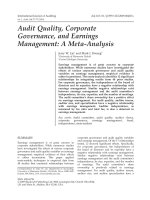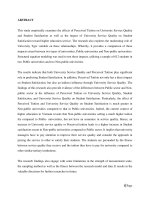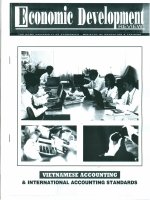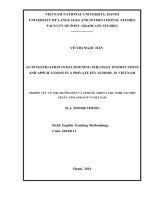Analyzing service quality via QFD and SERVQUAL applications in accommodation services and distance learning
Bạn đang xem bản rút gọn của tài liệu. Xem và tải ngay bản đầy đủ của tài liệu tại đây (3.87 MB, 126 trang )
ANALYZING SERVICE QUALITY VIA QFD AND
SERVQUAL: APPLICATIONS IN ACCOMMODATION
SERVICES AND DISTANCE LEARNING
ZHANG YU
NATIONAL UNIVERSITY OF SINGAPORE
2003
ANALYZING SERVICE QUALITY VIA QFD AND
SERVQUAL: APPLICATIONS IN ACCOMMODATION
SERVICES AND DISTANCE LEARNING
ZHANG YU
(B. ENG.)
A THESIS SUBMITTED
FOR THE DEGREE OF MASTER OF ENGINEERING
DEPARTMENT OF INDUSTRIAL AND SYSTEMS
ENGINEERING
NATIONAL UNIVERSITY OF SINGAPORE
2003
Acknowledgements
ACKNOWLEDGEMENTS
I would like to express my sincere gratitude to my research supervisor,
Associate Professor Tan Kay Chuan, not only for his invaluable guidance and useful
suggestions throughout the study and research process, but also for his care and
assistance during the whole period.
Besides, I am indebted to all other faculty members of the Department of
Industrial and Systems Engineering for their kind attention and advice in my study
and research.
I am also grateful to Fengling, Tang Yong, Yanni, Priya, Peichin, Gao Fei,
Shubin, He Bin, Vivek, and Zhang Jun who never hesitated to offer me help and
advice. For all those friends whose names are not listed, I would like to extend my
thanks to them for they made my stay in NUS an enjoyable memory. My special
appreciation is expressed to Mr. Wu Fati for his enthusiastic and practical assistance
in the survey conducted through Beijing Huaxia Dadi Distance Learning Web.
Finally, my wholehearted thankfulness goes to my loving husband Mo, my
parents and my sister for their continuous encouragement, support and care.
---------------------
Zhang Yu
I
Table of Contents
TABLE OF CONTENTS
ACKNOWLEDGEMENTS
I
TABLE OF CONTENTS
II
SUMMARY
VI
LIST OF TABLES
VIII
LIST OF FIGURES
IX
NOMENCLATURE
X
Chapter 1. Introduction
1
1.1. Research Background and Motivation
1
1.2. Objective of the Thesis
3
1.3. Structure of the Thesis
3
Chapter 2. Literature Review
5
2.1. Service Quality
5
2.2. QFD
9
2.2.1. History of QFD
9
2.2.2. QFD Models
10
2.2.3. House of Quality (HOQ)
11
2.2.4. Benefits of QFD
14
2.2.5. Major Pitfalls of QFD
14
2.2.6. Development of QFD
16
II
Table of Contents
2.3. SERVQUAL
24
2.3.1. Original SERVQUAL
24
2.3.2. Development of SERVQUAL
26
2.3.3. Some Cautions on the Use of SERVQUAL
28
2.3.4. Some Alternatives to SERVQUAL
32
2.4. Conclusions
37
Chapter 3. Employing Fuzzy Set Theory with SERVQUAL to Evaluate
Service Quality
38
3.1. Motivation for Employing Fuzzy Set Theory
38
3.2. Fuzzy Set Theory and its Applications
39
3.3. Linguistic Variable
41
3.4. Fuzzy Number and Fuzzy Arithmetic
41
3.5. A Process Model for SERVQUAL Based on Linguistic Variables
43
3.6. Conclusion
47
Chapter 4. Using QFD to Evaluate Service Quality in Accommodation
Services by the National University of Singapore
49
4.1. Introduction
49
4.2. Applications of QFD in Higher Education
50
4.3. Data Collection
53
4.3.1. Gathering the Voice of Students
53
4.3.2. Preparation of the Questionnaire
54
4.4. Data Analysis
55
4.4.1. Analysis of the Ranked Perception of User Requirement and
Some Descriptive Statistics
55
III
Table of Contents
4.4.2. Category Comparison in Terms of Satisfaction and Importance
57
4.4.3. Analysis of Comparison of Perception Value in Terms of Location
and Degree
4.4.4. Analysis of Differences between Undergraduates and Graduates
4.5. House of Quality (HOQ)
59
60
61
4.5.1. Construction of the HOQ
61
4.5.2. Analysis of the HOQ
64
4.6. Discussion
66
Chapter 5. Using SERVQUAL to Measure Service Quality in Distance
Learning
68
5.1. Service Quality in Distance Learning
68
5.1.1. History of Distance Learning
68
5.1.2. Customer Satisfaction in A Distance Learning Program
71
5.1.3. Internet-based Learning
72
5.1.4. E-learning Services and System Provided by Huaxia Dadi Distance
Learning Web
5.2. Measuring Service Quality of Internet-based Learning
74
77
5.2.1. Introduction
77
5.2.2. Methodology
78
5.2.3. Data Analysis and Results
81
5.2.4. Discussion
89
Chapter 6. Conclusion
92
6.1. Concluding Remarks
92
IV
Table of Contents
6.2. Limitations and Suggestions for Future Research
94
References
96
Appendix A. Questionnaire for the Survey on Student Accommodation
Services by the National University of Singapore
108
Appendix B. Questionnaire for the Survey on Service Quality of Web-based
Course Offered by HuaXia DaDi Distance Learning
Services Company (in Chinese)
111
Appendix C. Questionnaire for the Survey on Service Quality of Web-based
Course Offered by HuaXia DaDi Distance Learning
Services Company (in English)
113
V
Summary
SUMMARY
Service quality has become one of the most researched areas today, because
the service industries are playing a more and more important role in the overall
economy of the world. This thesis focuses on issues about how to analyze, measure
and improve service quality in specific educational settings. Quality Function
Deployment (QFD) is a systematic tool to translate customer requirements into
appropriate technical requirements. A case study of identifying and meeting students’
needs of accommodation services is presented. Furthermore, a popular approach to
measure service quality is SERVQUAL. In this thesis, another case study presents
how to measure service quality of Internet-based Learning provided by a Chinese
major distance learning services provider. It also overcomes linguistic problems by
employing fuzzy set theory.
This thesis consists of 6 chapters. Chapter 1 is a brief introduction of this
thesis. Chapter 2 is a literature survey that provides a thorough review of two existing
research methods for evaluating service quality, QFD and SERVQUAL. Chapter 3
presents a proposed process model to employ fuzzy set theory in SERVQUAL to
evaluate service quality. Following this, two case studies are presented in Chapters 4
and 5. Chapter 4 is an application of QFD in student accommodation services by the
National University of Singapore. It demonstrates how QFD can be used to measure
customer satisfaction in an important component of higher education. Chapter 5
presents a survey conducted in a Chinese major distance learning services provider,
which aims to analyze and evaluate service quality in Internet-based Learning. This is
VI
Summary
based on the SERVQUAL model. We deal with some limitations of the SERVQUAL
model in this chapter: unstable dimensionality and ambiguity of inputs. A method of
measuring perceived service quality based on triangular fuzzy numbers is used in this
chapter. At the end of the thesis, the conclusion is given in Chapter 6.
VII
List of Tables
LIST OF TABLES
Table 2.1.
SERVQUAL+ formats (adapted from Parasuraman et al., 1994)
34
Table 4.1.
Categorized user requirements
54
Table 4.2.
Ranked perceptions of user requirements (descending) and some
descriptive statistics
56
Table 5.1.
Models of distance education - a conceptual framework (reproduced
from Taylor, 1995)
70
Table 5.2.
SERVQUAL statements
80
Table 5.3.
Rotated component matrix
83
Table 5.4.
Dimensions of service quality for Internet-based Learning
84
Table 5.5.
Service quality evaluations by triangular fuzzy number for each
attribute
86
Service quality evaluations by triangular fuzzy number for each
dimension
87
Table 5.6.
VIII
List of Figures
LIST OF FIGURES
Figure 2.1.
Definition of service quality (reproduced from Fitzsimmons and
Fitzsimmons, 2001)
8
Service quality gap model (reproduced from Parasuraman et al.,
1985)
8
Figure 2.3.
Diagram of HOQ (reproduced from Fuller, 1998)
12
Figure 3.1.
~
~
The α-cut set A α of a normal and convex fuzzy number A
42
Figure 3.2.
~
A triangular fuzzy number A
42
Figure 3.3.
The ith customer’s linguistic importance term
44
Figure 3.4.
The ith customer’s linguistic satisfaction term
45
Figure 4.1.
Category comparison in terms of satisfaction and importance
58
Figure 4.2.
Comparison of perception value in terms of location
59
Figure 4.3.
Difference of perception of each requirement between undergraduates
and graduates
60
Figure 4.4.
Comparisons between Prince George’s Park and Gillman Heights in
terms of satisfaction degree of graduate students
61
Figure 4.5.
A completed HOQ for student accommodation services by NUS
65
Figure 5.1.
The framework of ELS platform used by Huaxia Dadi Distance
Learning Web
75
Figure 2.2.
IX
Nomenclature
NOMENCLATURE
AHP
analytic hierarchy process
AI
artificial intelligence
BNP
best nonfuzzy performance
CRAD
customer requirements analysis and deployment
DSS
decision support system
ELS
e-learning system
GSS
group support system
HOQ
house of quality
IS
information system
MBNQA
malcolm balridge national quality award
MCDM
multicriteria decision making
OCRA
operational competitiveness rating
QFD
quality function deployment
QM III
quantification method of type III
TOPSIS
technique for order preference by similarity to ideal solution
TQM
total quality management
TVM
total values management
UIS
user information satisfaction
USISF
user satisfaction with the information service function
VOC
voice of the customer
ZMET
zaltman metaphor elicitation technique
X
Chapter 1
Introduction
Chapter 1
Introduction
1.1. Research Background and Motivation
It is common knowledge that improvement in our standard of living is highly
dependent on better quality in the service sector. Services are taking on increasing
importance in the worldwide economy. To compete effectively in today’s vigorous
global competition, service providers have realized that they must instill and practice
service quality throughout their organizations to survive and grow. The interest in
service quality parallels the focus on quality, Total Quality Management (TQM), and
satisfaction in business (Fisk et al., 1993).
In today’s changing global environment, many educational institutions are also
facing intensifying competition. In order to achieve competitive advantage and
efficiency, institutions have to seek ways to differentiate themselves. Higher
education possesses all the characteristics of a service industry (Shank et al., 1995).
One strategy that has been related to success is the delivery of high service quality,
especially during times of intensive competition both domestically and internationally
(Rao and Kelkar, 1997). This concept has been the subject of many conceptual and
empirical studies, and it is generally accepted that service quality has positive
implications for an organization’s performance and competitive position, same to an
educational institution.
The study of service quality should be aimed at understanding, meeting and
surpassing customer needs and expectations. There are many methods that can be
1
Chapter 1
Introduction
used to study service quality. The following two prominent methods are employed to
study service quality frequently: Quality Function Deployment and SERVQUAL.
QFD is a customer-oriented planning process for translating customers’ needs into
technical requirements at every stage of a product’s life cycle and it also has been
introduced into the service sector to design and develop quality services. SERVQUAL
is one of the most widely used instruments to evaluate service quality, which defines
service quality as the gap between predicted service and perceived service.
However, despite the vast amount of research done in the area of service
quality in education, quality related issues have received little research attention other
than teaching activities. First, although QFD has been applied in higher education for
many years, most has been focused on research and teaching (Chan and Wu, 2002).
Few efforts, however, have been paid to improve the quality of education in other
activities, like accommodation, enrollment, and extra-curricula activities. Second,
distance learning is increasingly popular and becoming a complementary way of
learning in formal education at schools as well as in continuous education of
employees, because of its advantages over the traditional education courses. An
overwhelming number of distance learning programs now are available through a
multitude of delivery mechanisms, especially the Internet. To respond to this demand,
universities and other centers of higher education must recognize and meet the needs
of learners who are quite different from the traditional students of the past. Although
many conceptual and empirical studies have been done in the area of service quality,
however, quality issues related to distance learning, especially for online programs,
have received little research attention (Fresen, 2002 and Sonwalkar, 2002).
The above reasons mentioned motivated us to undertake this study. Besides,
services have many characteristics that make the evaluation of quality much more
2
Chapter 1
Introduction
difficult than hard products. These characteristics include intangibility, heterogeneity,
variation, subjection, customer participation and perishability (Chen, 2001). Since
many intangible factors and the customers’ subjective judgments can influence
customer satisfaction, measuring service quality becomes a great challenge for every
organization.
1.2. Objective of the Thesis
This exploratory research focuses on how to analyze and improve service
quality to achieve final excellence in specific educational settings. This study attempts
to address the following three issues:
First, how to address the ambiguity and the subjectivity of the customers’
judgments in the measurement of service quality?
Second, how to use QFD and SERVQUAL to analyze, evaluate and improve
service quality?
Third, what should we know in order to improve service quality in
accommodation services and distance learning?
By employing QFD, SERVQUAL and fuzzy set theory, this thesis explores
the above three issues and provides their feasible solutions.
1.3. Structure of the Thesis
This thesis consists of six chapters. The contents of each chapter are
summarized as follows. Chapter 1 is a brief introduction to this thesis. Chapter 2 is a
literature survey that provides a thorough review of the following two existing
research methods for analyzing service quality: QFD and SERVQUAL. In Chapter 3,
how to employ the fuzzy set theory with SERVQUAL is discussed. The proposed
3
Chapter 1
Introduction
process model employing the fuzzy set theory in the service quality evaluation is
developed.
Two case studies have been conducted and are presented in Chapter 4 and
Chapter 5. Chapter 4 is an application of QFD in student accommodation services by
the National University of Singapore. It demonstrates how QFD can be used to
measure customer satisfaction in an important component of higher education.
Chapter 5 presents a survey conducted in a Chinese major distance learning services
provider, which aims to analyze and evaluate service quality of Internet-based
Learning, based on the SERVQUAL model. In this application, we deal with some
significant limitations of the SERVQUAL model. First, the number of dimensions in
SERVQUAL is not unique, which is called unstable dimensionality. Second, when
applying the SERVQUAL model, many intangible attributes, which are difficult to
measure accurately, will result in the ambiguity of inputs. A method of measuring the
perceived service quality based on triangular fuzzy numbers is used in this chapter.
Finally, in Chapter 6, we present the conclusions and also outline areas for
future research.
4
Chapter 2
Literature Review
Chapter 2
Literature Review
With a view to identify the main framework for this research, the aim of this
literature review is to provide an initial mapping for the origination and development
of QFD and SERVQUAL including some limitations in the existing culture, which
stress the motivation of this study.
2.1. Service Quality
From a review of the literature on quality, it has been found that early research
efforts concentrated on defining and measuring the quality of tangible products, while
the service sector was ignored. Gronroos (1990) noted that product quality was
traditionally linked to the technical specification of goods, with most definitions of
quality arising from the manufacturing sector where quality control has received
extensive attention and research. Crosby (1979) defined quality of goods as
“conformance to requirements”; Juran (1980) defined it as “fitness for use”; and
Garvin (1983) measured quality by counting the frequency of “internal” failures
(those observed before a product left the factory) and “external” failures (those
incurred in the field after a unit had been installed). These product-based definitions
of quality may be appropriate to the goods-producing sector. However, knowledge
about the quality of goods is insufficient to understand service quality (Parasuraman
et al., 1985).
5
Chapter 2
Literature Review
Services are generally described in terms of four unique attributes (Lovelock,
1981; Gronroos, 1990; Zeithaml and Bitner, 1996), namely:
•
Intangibility
•
Heterogeneity
•
Inseparability
•
Perishability
Oldfield and Baron (2000) proposed that service quality is made up of three
significant dimensions: service processes, interpersonal factors, and physical evidence.
Service processes are the system of company policies and the system of service
delivery that a service provider adopts, which will determine the way the service is
provided to the customer. For example, in some instances, the rigid nature of an
organization can cause dissatisfaction when employees are unable to deliver good
service to a customer (Normann, 1991). Additionally, it has been suggested that
frontline employees can influence the degree of satisfaction that a customer
experiences (Bateson, 1977; Bitner et al., 1990).
Interpersonal factors illustrate that the interaction between customer and
service organization is also critical to quality service. People who deliver the service
are of key importance to both the customers they serve and the employer they
represent. For example, the employee’s manner and appearance all play a part in
determining how satisfied the customer is with the service encounter.
Physical evidence is concerned with the tangible elements associated with a
service. Customers cannot see a service but they can see and experience various
tangible elements associated with the service, such as facilities, employees, pamphlets,
leaflets, etc.
6
Chapter 2
Literature Review
A more popular understanding of service quality is that five principle
dimensions are identified for customers to use to judge service quality. Customers use
those dimensions to make their assessment, which are based primarily on a
comparison of their expectations of the service desired with their perceptions of the
service delivered. This popular definition of service quality is shown in the Figure 2.1.
And service quality gap model demonstrates that five different types of gaps could
occur when customers’ expectations do not meet their perceptions of the service (see
Figure 2.2):
1. Gap between consumer expectation and management perception, which results
from a lack of understanding of what consumers expect.
2. Gap between management’s perception and service quality specifications,
which results from a difference between the established service quality
specifications and what the management perceives to be customer
expectations.
3. Gap between service quality specifications and service delivery, which results
from a discrepancy between service quality specifications and inadequate
service delivery, such as, poor employee performance.
4. Gap between service delivery and external communications, which results
from a discrepancy between the quality delivered and the quality promised in
the service provider’s promotional message.
5. Gap between perceived service and delivered service, which results from the
previous gaps.
7
Chapter 2
Literature Review
Word of
Mouth
Dimensions of
Service Quality
Personal
needs
Past
experience
Expected
service (ES)
Reliability
Responsiveness
Assurance
Empathy
Tangibles
Perceived
service (PS)
Perceived Service Quality
1. Expectation exceeded
ES
ES=PS (satisfactory quality)
3. Expectation not met
ES>PS (Unacceptable quality)
Figure 2.1. Definition of service quality (reproduced from Fitzsimmons and
Fitzsimmons, 2001)
Word-of-mouth
communications
Customer
Personal needs
Past experience
Expected service
Gap 5
Perceived service
Service delivery (including
pre- and post-contacts)
Marketer
Gap 1
Gap 3
Gap 4
External communications to
consumers
Translation of perceptions into
service quality specifications
Gap 2
Management perceptions of
consumer expectations
Figure 2.2. Service quality gap model (reproduced from Parasuraman et al., 1985)
8
Chapter 2
Literature Review
2.2. QFD
QFD comes from the original Japanese phase: Hin Shitsu Kino Ten Kai
(Lockamy III and Khurana, 1995), and the three characters mean:
•
Hin Shitsu, which usually means quality, feature or attribute;
•
Kino, which usually means function or mechanization; and
•
Ten Kai, which usually means deployment, diffusion, development or
evolution.
Akao (1990) defined QFD as converting consumers’ demands into “quality
characteristics” and developing a design quality for the finished product by
systematically deploying the relationships between the demands and the
characteristics, starting with the quality of each functional component and extending
the deployment to the quality of each part and process. According to Sullivan (1986),
QFD is an overall concept that provides a means of translating customer requirements
into the appropriate technical requirements for each stage of product development and
production.
In general, QFD is a management tool that provides a structured method for
translating customer needs and expectations into the technical requirements for each
stage in product or service development. Its power lies in the fact that it uncovers an
organization’s processes and how these processes interact to create customer
satisfaction and profit (Raynor, 1994).
2.2.1. History of QFD
QFD is a method developed in Japan in the late 1960s under the umbrella of
total quality control to provide a map for interfunctional planning and communication
(Akao, 1990). In 1972, when QFD was applied at the Kobe shipyards of Mitsubishi
9
Chapter 2
Literature Review
Heavy Industries in Japan, it emerged as a viable methodology. It rapidly spread to
the US in the 1980s and later to many countries in many industries. In the US, the first
recorded case study in QFD was in 1986 (King, 1989). Kelsey Hayes used QFD to
develop a coolant sensor, which fulfilled critical customer requirements like “easy-toadd coolant”, “easy-to-identify unit” and “provide cap removal instructions”. Later, a
great literature on QFD evolved (Chan and Wu, 2002).
2.2.2. QFD Models
QFD has two popular models to illustrate its process. One is the four-phase
model developed by Clausing (1994): House of Quality (HOQ), Parts Deployment,
Process Planning, and Production Planning. The four-phase model is based on the
following four components (Sullivan, 1986):
1. Overall customer requirement planning matrix - translates the general
customer requirements into specified final product control characteristics;
2. Final product characteristic development matrix - translates the output of the
planning matrix into critical component characteristics;
3. Process plan and quality control charts - identify critical product and process
parameters and develop check points and controls for these parameters; and
4. Operating instructions - identify operations to be performed by plant personnel
to ensure that important parameters are achieved.
The other model is called the “Matrix of Matrices” by Akao (1990). It is
normally presented as a system of thirty matrices, charts, tables, or other diagrams,
which is considered tremendous and far-reaching and is not dominated in the QFD
literature (Cohen, 1995).
10
Chapter 2
Literature Review
2.2.3. House of Quality (HOQ)
The HOQ is the most commonly used matrix in the traditional QFD
methodology. To deploy the voice of customer (VOC), a well-designed questionnaire
is needed to find out what customers want. This information then needs to be
incorporated into the design, through the HOQ technique. HOQ is a kind of
conceptual map that provides a means for inter-functional planning and
communications (Hauser and Clausing, 1988).
HOQ recognizes the inter-relationships between customer requirements and
design variables and between the design variables themselves. The technique appears
complex, but in reality it is no more than a method of organizing and analyzing
information. Figure 2.3 below shows the basic HOQ model. The numbered
paragraphs that follow, which work through the model one step at a time, are crossreferenced with the figures in the diagram (Fuller, 1998).
1. List Customer requirements in “What”.
2. Rate them in order of importance from 1 to 10 (with 10 being “essential to the
customer”).
3. In “How”, list how you are going to satisfy the specific customer whats - i.e.
the basic elements of design to satisfy the customer requirements.
4. In the Relationships Matrix, cross-reference the strong, medium and weak
relationships. As the top box indicates, they often carry points of 9, 3, and 1
respectively.
5. The “roof” of the house is designed to cross-correlate the “How” against each
other so that the conflicting and complimentary characteristics can be
identified. The arrows under the roof indicate whether the design aspect is
11
Chapter 2
Literature Review
preferable at its maximum value. This indicates the direction in which you are
trying to design your product or service.
6. If required, it is possible to incorporate a benchmarking study. The symbols
are used to indicate comparative performance.
Figure 2.3. Diagram of HOQ (reproduced from Fuller, 1998)
7. The organizational difficulty row can be included to indicate the degree of
difficulty in achieving that particular design feature.
12
Chapter 2
Literature Review
8. The design target values in this section are for the listing of the specific overall
design values.
9. This section is optimal and is the technical benchmarking grid. Here, a
comparison between the basic technical specification and the competition can
be made.
10. The final grid is for prioritizing the design program. First, an absolute rating is
obtained from importance multiplied by strong/medium/weak relationships,
and then adding all the vertically generated figures. Finally, relate them to
each other, such that the highest absolute rating is given the priority number.
The process of building the HOQ is quite different from building a real house.
First, the HOQ constructions begin with the left room - the collection of customer
needs and their prioritization. Second, the technical characteristics that will satisfy the
customer requirements are figured out. Third, after gathering the VOC and coming up
with technical characteristics, we should build the center of the HOQ, which indicates
how each technical characteristic affects each customer need. Thereafter comes the
construction of the roof of the HOQ. This is a matrix indicating relationships among
technical characteristics. The roof is a good indicator of future design trade-off that
may have to be made. Finally, we should build the technical matrix. This last section
contains the most important and useful information that may be considered as the
output of the HOQ. The technical priority provides a rank ordering of the technical
characteristics. This serves as a guide for making trade-offs in resource allocation.
Additional information in this section may consist of technical difficulties, estimated
costs, and the determined importance of meeting a particular target specification.
13
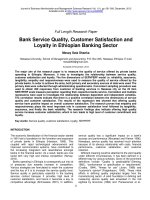
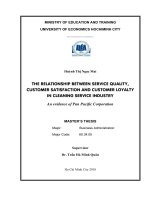
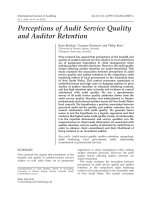

![[cg-aq-fc] adeyemi and fagbemi - 2010 - audit quality, corporate governance and firm characteristics in nigeria](https://media.store123doc.com/images/document/2015_01/06/medium_ihr1420548467.jpg)
